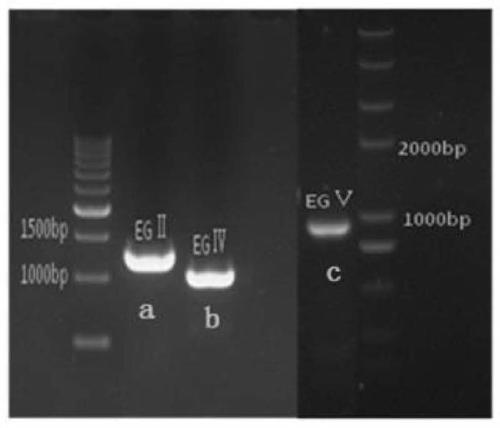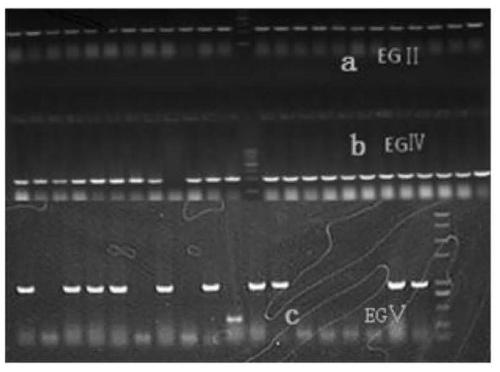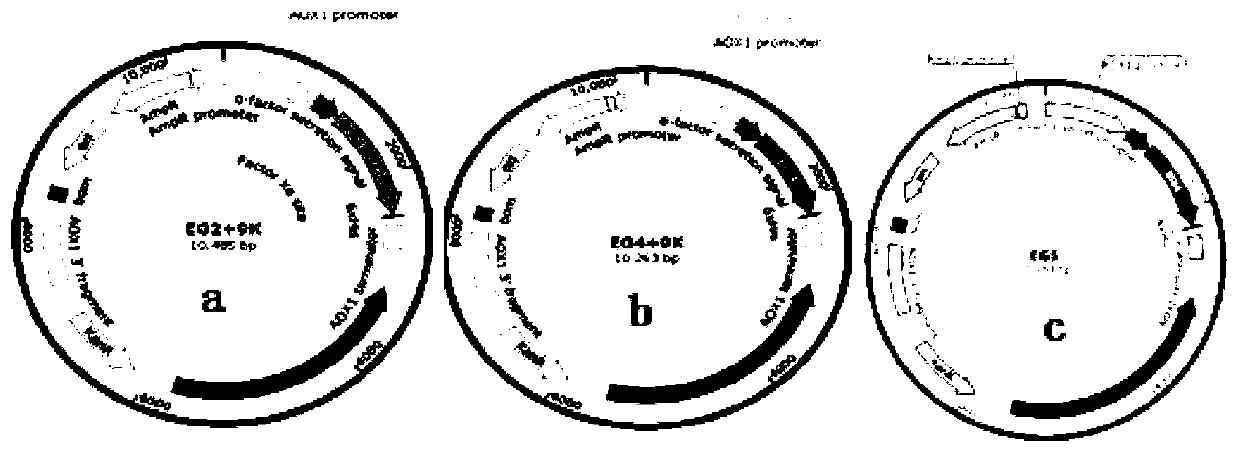Method for constructing heterologous expression endoglucanases EG II, EG IV and EG V in pichia pastoris
A technology of endoglucanase and Pichia pastoris, which is applied in the field of genetic engineering, can solve the problems of low enzymatic hydrolysis efficiency and lack of cellulase system, so as to improve industrial production potential, improve expression efficiency, and induce good effect Effect
- Summary
- Abstract
- Description
- Claims
- Application Information
AI Technical Summary
Problems solved by technology
Method used
Image
Examples
Embodiment example 1
[0026] Implementation Case 1 Cloning of target gene
[0027] 1. Take the Trichoderma reesei QM9414 spore suspension stored in a glycerol tube out of the -80°C refrigerator and place it in ice (or 4°C refrigerator) to thaw until the spore suspension completely melts. Shake the spore suspension to mix evenly, dip the inoculation loop with a small amount of bacterial solution, and streak on the PDA medium plate for inoculation. After the plate was sealed with parafilm, it was placed in a 28°C incubator for cultivation. Cultivate for about 5-7 days until the surface of the medium is covered with green spores. The plates were taken out of the incubator and placed in a 4°C refrigerator for later use.
[0028] 2. Inoculate fresh spores on cellulase solid induction culture, spread sterilized cellophane on the surface, and let the culture stand until the hyphae grow out. The hyphae were scraped off from the cellophane and treated with a liquid nitrogen freezer grinder. RNA was extra...
Embodiment example 2
[0030] Implementation case 2 Construction of Ppic9k-EGⅡ, EGⅣ, EGⅤ expression vectors
[0031] 1. Put the Buffer in ice first, after it is fully melted and mixed evenly, prepare a double enzyme digestion reaction system, mix evenly after the preparation is complete, put it in a 37°C water bath, and digest for 1 hour. After digestion, use a purification recovery kit to recover the digested product to remove residual enzymes and oligonucleotides in the digested product, so as not to affect the subsequent connection of the plasmid and the target gene.
[0032] 2. With EcoRI at the 5' end and NotI at the 3' end as the restriction site, insert the downstream of the Ppic9k plasmid vector promoter AOX1 to construct the expression vector Ppic9k-EGⅡ, EGⅣ, EGⅤ. See the expression vector map image 3 . Colony PCR verification see figure 2 . The expression vectors were verified by single enzyme digestion to confirm that the expression vectors Ppic9k-EGⅡ, EGⅣ and EGⅤ were successfully c...
Embodiment example 3
[0033] Implementation Case 3 Linearized expression vectors Ppic9k-EGⅡ, EGⅣ, EGⅤ and performed electrotransformation
[0034] 1. Use bglⅠ as the linearization site of the Ppic9k-EGⅡ, EGⅣ, EGⅤ expression vector to realize the linearization of the expression vector, and verify the linearized plasmid by nucleic acid electrophoresis, see Figure 4 . Transformed into Pichia pastoris GS115 by electrotransformation, and plated to obtain transformants.
[0035] 2. Use the SDS pyrolysis method to roughly extract the genome of the recombinant yeast transformant obtained in 1, and verify its correctness and phenotype by PCR. The nucleic acid map of the genome PCR is shown in Figure 5 .Use the antibiotic concentration gradient to screen multi-copy transformants, and screen out the colonies that can grow normally on high-concentration resistance plates.
PUM
 Login to View More
Login to View More Abstract
Description
Claims
Application Information
 Login to View More
Login to View More - R&D
- Intellectual Property
- Life Sciences
- Materials
- Tech Scout
- Unparalleled Data Quality
- Higher Quality Content
- 60% Fewer Hallucinations
Browse by: Latest US Patents, China's latest patents, Technical Efficacy Thesaurus, Application Domain, Technology Topic, Popular Technical Reports.
© 2025 PatSnap. All rights reserved.Legal|Privacy policy|Modern Slavery Act Transparency Statement|Sitemap|About US| Contact US: help@patsnap.com



